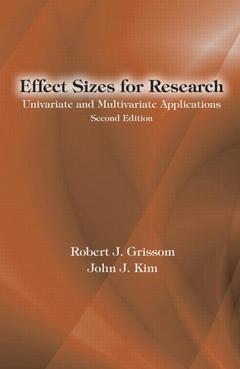Effect Sizes for Research (2nd Ed.) Univariate and Multivariate Applications, Second Edition
Auteurs : Grissom Robert J., Kim John J.

Noted for its comprehensive coverage, this greatly expanded new edition now covers the use of univariate and multivariate effect sizes. Many measures and estimators are reviewed along with their application, interpretation, and limitations. Noted for its practical approach, the book features numerous examples using real data for a variety of variables and designs, to help readers apply the material to their own data. Tips on the use of SPSS, SAS, R, and S-Plus are provided. The book's broad disciplinary appeal results from its inclusion of a variety of examples from psychology, medicine, education, and other social sciences. Special attention is paid to confidence intervals, the statistical assumptions of the methods, and robust estimators of effect sizes. The extensive reference section is appreciated by all.
With more than 40% new material, highlights of the new editon include:
- three new multivariate chapters covering effect sizes for analysis of covariance, multiple regression/correlation, and multivariate analysis of variance
- more learning tools in each chapter including introductions, summaries, "Tips and Pitfalls" and more conceptual and computational questions
- more coverage of univariate effect sizes, confidence intervals, and effect sizes for repeated measures to reflect their increased use in research
- more software references for calculating effect sizes and their confidence intervals including SPSS, SAS, R, and S-Plus
- the data used in the book are now provided on the web along with new data and suggested calculations with IBM SPSS syntax for computational practice.
Effect Sizes for Research covers standardized and unstandardized differences between means, correlational measures, strength of association, and parametric and nonparametric measures for between- and within-groups data.
Intended as a resource for professionals, researchers, and advanced students in a variety of fields, this book is also an excellent supplement for advanced statistics courses in psychology, education, the social sciences, business, and medicine. A prerequisite of introductory statistics through factorial analysis of variance and chi-square is recommended.
1. Introduction 2. Confidence Intervals for Comparing the Averages of Two Groups 3. The Standardized Difference Between Means 4. Correlational Effect Sizes and Related Topics 5. Parametric and Nonparametric Effect Size Measures that Go Beyond Comparing Two Averages 6. Effect Sizes for One-Way ANOVA and Nonparametric Approaches 7. Effect Sizes for Factorial Designs 8. Effect Sizes for Categorical Variables 9. Effect Sizes for Ordinal Categorical Dependent Variables (Rating Scales) 10. Effect Sizes for Multiple Regression/Correlation 11. Effect Sizes for Analysis of Covariance 12. Effect Sizes for Multivariate Analysis of Variance
Robert J. Grissom is a Professor Emeritus and Adjunct Professor of Psychology at San Francisco State University and a Consultant in Statistics. He received his Ph.D. in Psychology from Princeton University. Co-founder of the Graduate Program in Psychological Research at San Francisco State, Dr. Grissom has written numerous chapters and articles on effect size methodology.
John J. Kim is a Professor of Psychology at San Francisco State University. He received his Ph.D. from the Department of Brain and Cognitive Sciences, Massachusetts Institute of Technology in 1993. The current Associate Vice President for Academic Resources at San Francisco State, Dr. Kim has written numerous chapters and articles on effect size methodology.
Date de parution : 12-2011
15.2x22.9 cm
Date de parution : 01-2012
15.2x22.9 cm
Thèmes d’Effect Sizes for Research :
Mots-clés :
standardized; difference; hypothesis; dependent; variable; unstandardized; sample; ibm; ANOVA Output; spss; Traditional ANCOVA; Independent Groups; Standardized Difference Effect Size; Anorexia Nervosa; Random Assignment; Factorial MANOVA; Point Biserial Correlation; IBM SPSS; Unstandardized Difference; Omnibus Effect Size; CI; Generalized Odds Ratio; NULL HYPOTHESIS SIGNIFICANCE TESTING; Winsorized Variances; Factorial ANOVA; Ordinal Categorical Data; Standardized Difference; Semipartial Correlation; Cumulative Odds Ratio; Ordinal Categorical Variables; Ordinal Categorical; Omnibus MANOVA; Dummy Coding; Obtained Significance Level



